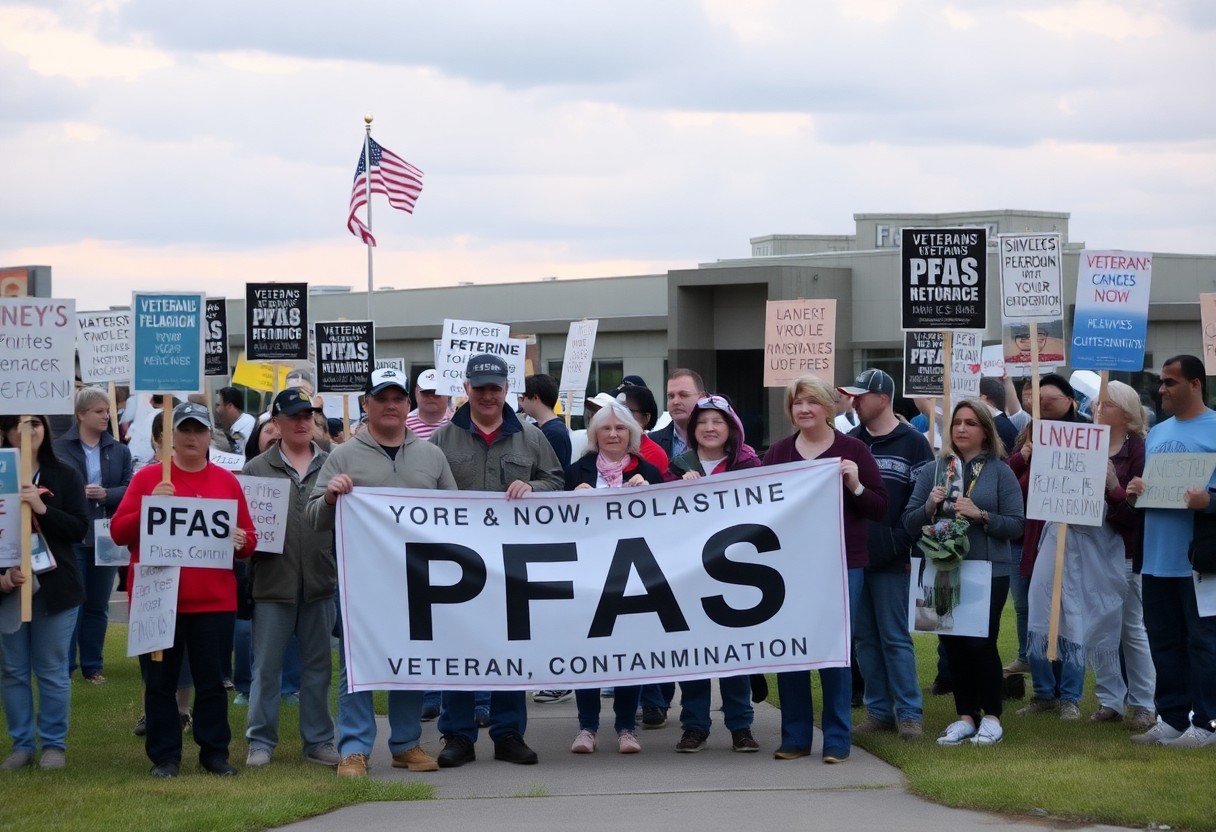PFAS, or per- and polyfluoroalkyl substances, are a group of man-made chemicals that have become pervasive in water supplies across the United States. You may be unknowingly exposed to these hazardous contaminants through drinking water, food packaging, and everyday products. PFAS are notorious for their environmental persistence and potential health risks, including issues with liver function and immune system effects. Understanding the implications of PFAS in your water is crucial for safeguarding your health and advocating for necessary changes in environmental policies that affect your community.

Understanding PFAS
To grasp the severity of PFAS contamination, it’s crucial to understand these synthetic compounds. PFAS, or per- and polyfluoroalkyl substances, are a group of man-made chemicals widely used for their water- and grease-resistant properties. Known as “forever chemicals,” they persist in the environment and your body, posing significant health concerns.
Definition and Chemical Structure
Behind their utility in consumer products, PFAS compounds possess unique chemical structures characterized by carbon-fluorine bonds, which are exceptionally strong. This resilience is what gives PFAS their desirable properties, making them effective in various applications, from non-stick cookware to waterproof clothing.
Sources of Contamination
Around the world, PFAS can originate from numerous sources, including industrial discharges, landfill leachates, and the use of firefighting foams. These substances often infiltrate you and your community’s water supply, affecting both surface and groundwater.
Understanding the sources of contamination is vital for addressing the PFAS issue. Many industrial processes release PFAS directly into the environment, particularly in manufacturing facilities and refineries. Additionally, firefighting foam containing PFAS has been a major contributor, especially at military bases and airports. When these products are improperly disposed of or used excessively, they can leach into soil and water, affecting the quality of drinking water sources and posing health risks to you and your community.
Health Impacts of PFAS
Clearly, the health impacts of PFAS (per- and polyfluoroalkyl substances) are a significant concern, as these chemical compounds can accumulate in your body over time, leading to various adverse health effects. Studies have indicated links between PFAS exposure and conditions such as liver damage, thyroid disease, decreased fertility, and developmental issues in children. Long-term exposure may also increase the risk of certain cancers, making it imperative to understand how PFAS can affect your health and wellbeing.
Toxicological Effects
Above all, the toxicological effects of PFAS on your health can be profound and multifaceted. These substances can disrupt endocrine functions, alter immune responses, and impact metabolic processes. Animal studies have demonstrated kidney and liver toxicity, while human studies have associated PFAS with elevated cholesterol levels and possible hormonal imbalances. Understanding these toxicological effects can empower you to make informed choices about your exposure.
Vulnerable Populations
PFAS exposure poses particular risks to certain vulnerable populations, including children, pregnant individuals, and those with preexisting health conditions. These groups may experience heightened sensitivity to the adverse effects of PFAS due to developing bodies or compromised immune systems, making it vital to consider their specific needs when addressing PFAS contamination.
Even among the vulnerable populations, children are especially at risk due to their smaller body size and rapid growth. Prenatal exposure to PFAS can disrupt fetal development, potentially leading to long-term health implications. Pregnant individuals may also face increased risks of complications such as low birth weight and preterm delivery. Additionally, those with existing health conditions like autoimmune disorders may experience exacerbated symptoms. Recognizing these vulnerabilities can help inform targeted interventions to protect those most affected by PFAS exposure.
Regulatory Framework
One of the most pressing issues surrounding PFAS in water is the regulatory framework that governs its management and oversight. While some states have begun to implement their own regulations, there remains a lack of cohesive national standards. This inconsistency can leave you vulnerable to contaminated water sources, as accountability and oversight practices differ notably between regions.
Current Regulations
Regulations surrounding PFAS vary widely across states and local jurisdictions, with some areas imposing strict limits on these substances in drinking water while others lack any specific guidelines. You may find that some states have established lower threshold levels for PFAS contaminants, highlighting a growing recognition of the potential health risks these chemicals pose.
Challenges in Enforcement
Along with uneven regulations, challenges in enforcement complicate the issue of PFAS contamination in water systems. You may often see inadequate monitoring and testing practices, making it difficult to hold organizations accountable for pollution.
Regulatory measures to combat PFAS contamination face many obstacles, particularly with funding limitations and insufficient resources for monitoring and testing. This can leave you exposed to harmful substances in your water supply. Additionally, complex chemical behaviors of PFAS compounds hinder detection and treatment processes, leaving authorities struggling to implement effective measures. As you navigate this landscape, be aware that local and state efforts can vary, often leading to gaps in protection for you and your community.
Detection and Measurement
Your awareness of PFAS contamination in water is heightened by understanding the importance of accurate detection and measurement. Reliable testing methods are important for identifying the presence and concentration of these harmful substances, allowing communities and individuals to take appropriate action and safeguard their health. Knowledge about detection techniques empowers you to advocate for safer water practices and policies.
Methods for Testing Water
Against the backdrop of a growing awareness of PFAS issues, various methods for testing water have emerged. These techniques include solid-phase microextraction and liquid chromatography-tandem mass spectrometry, among others, which enable detailed screening for PFAS compounds. Each method has its strengths, making it important for you to stay informed about which testing options are available in your community.
Innovations in Detection Technology
After recognizing the significance of PFAS in public health, scientists are continually advancing detection technology. These innovations enable faster and more precise identification of PFAS in water sources, providing you with reliable information about your drinking water.
Detection and measurement of PFAS have evolved significantly in recent years. Advanced sensor technologies and microfluidics are now capable of detecting even trace amounts of these pollutants, ensuring that no contamination goes unnoticed. Additionally, portable testing kits are becoming increasingly accessible, allowing you to test your water on-site for immediate results, fostering proactive measures to protect your health. With these advancements, you are better equipped to address water safety in your community.
Remediation Strategies
Despite the challenges posed by PFAS contamination, effective remediation strategies can help mitigate risks and restore water quality. These strategies often involve a combination of advanced technologies and sustainable practices that target the removal of harmful substances from water supplies. Engaging in these practices not only protects public health but also enhances environmental integrity.
Treatment Options
Between various treatment options, technologies such as activated carbon filtration, ion exchange, and advanced oxidation processes prove effective for removing PFAS compounds from water. Each method has its own advantages, and selecting the right option depends on factors like the type and concentration of PFAS present in your water source.
Role of Water Management Agencies
Along with remediation strategies, water management agencies play a vital role in addressing PFAS contamination. These agencies are responsible for monitoring water quality, developing regulations, and implementing treatment solutions to effectively manage PFAS in water supplies.
Also, you should understand that water management agencies collaborate with various stakeholders to enhance public awareness regarding PFAS contamination. They often conduct water testing, initiate public health campaigns, and foster community engagement to address your concerns about water safety. Their role is instrumental in establishing regulatory frameworks that prioritize the protection of your drinking water while also allocating resources towards innovative treatment technologies. By actively working to manage PFAS contamination, these agencies help ensure a safer, more reliable water supply for you and your community.
Case Studies
Many communities across the United States have encountered serious contamination issues linked to PFAS in their water supply. Here are some notable case studies:
- Newburgh, New York: The drinking water was contaminated with PFOS levels over 400 ppt, primarily due to firefighting foam.
- Hinkley, California: Widespread PCE contamination linked to Pacific Gas and Electric, leading to elevated PFAS levels.
- North Carolina: The Cape Fear River has documented GenX levels exceeding 100 ppt, affecting local water supplies.
- South Bend, Indiana: Investigations revealed PFAS levels in drinking water were above the suggested safety limits.
National and Regional Examples
With numerous sites across the nation showcasing significant PFAS contamination, it’s necessary to acknowledge both national and regional examples. Case studies reveal that communities in Michigan, New Jersey, and California have reported levels of PFAS far exceeding safety recommendations, forcing officials to re-evaluate water safety standards.
Community Responses
Below, affected communities have risen to the challenge to tackle the PFAS crisis. Many residents have actively organized campaigns, demanding federal and state agencies to take action for proper environmental regulation and safer drinking water solutions.
Further, grassroots movements and local organizations have successfully pressured policymakers for stricter regulation on PFAS. Some communities have implemented innovative filtration systems to reduce contamination levels. Importantly, public awareness campaigns help educate citizens about the dangers of PFAS to both human health and the environment, emphasizing the need for proactive community engagement to combat this pressing issue.



















